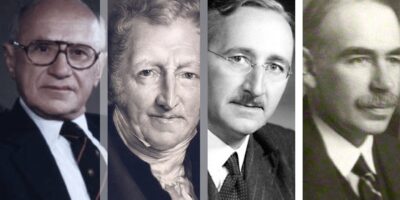Matt Ridley on Innovation

When Matt Ridley speaks, you listen. When he writes a book for the first time in five years, you read it, for its wonderful British irony and its big-picture wisdom – not once, but many times. Having been busy with his position in the House of Lords as well as a popular speaker and campaigner for Brexit, his book writing rate has regrettably slowed down.
After The Rational Optimist in 2010 and The Evolution of Everything in 2015, the current title, released in the U.S. this month, has been long in the making: How Innovation Works, with its American subtitle And Why It Flourishes In Freedom, appeals to anyone who appreciates spontaneous orders and wants to examine many implicitly-held beliefs about technology, development, and government.
As a great Douglas Adams fan, I was excited to learn that Ridley wrapped his story with Marvin – the chronically depressed robot of Hitchhiker’s Guide to the Galaxy whose main trait is “a brain the size of a planet” – and the Infinite Improbability Drive on the starship Heart of Gold.
Appreciating the countless and infinite ways in which materia could organize itself, creating new things of great use to serve human needs is astonishing. It is a testament to human ingenuity how truly improbable the arrangement of atoms into cars or computers or nuclear reactors are.
We tend to think about innovation as inventions and particularly about the inventors associated with them: Newton, Edison, Bell, Watt, Arkwright, Whitney, Jobs, Bezos. We celebrate these great men in full agreement with the Great Man Theory of history and technical inventions, a deeply-held conviction that Ridley aims to fully debunk.
But while these enterprising inventors quickly come to mind, ‘innovation’ is not quite ‘invention,’ even though invention and technology usually form part of it. Incredible technical inventions are one thing, but innovation requires something more: useful application and, interestingly enough, prices coming down. The reduction in prices is what matters for innovation to spread and be widely adopted. Like the printing press and the steam engine, interesting things start to happen when prices fall – not just because an innovation is esteemed among secluded aristocrats.
Innovation, says Ridley, is like procreation; ideas, techniques, skills, and knowledge combine serendipitously into other ideas, techniques and knowledge. It’s unsurprising that the writer of The Evolution of Everything, a trained biologist, and the originator for the quip “ideas having sex” would eventually formulate this position: Repeat long enough and often enough – and don’t ban, prevent, regulate or confiscate the spoils – and there will be endless improvements of human affairs.
Ridley even goes one step further and treats innovation as an extension of human evolution: “innovating” as a gradual process of trial-and-error and selection precisely mirrors evolution in a hodgepodge of incremental improvements, experimentation and simultaneous innovations.
Why do we care about this? Aren’t we merely splitting hairs in a terribly niche area of social and economic development?
Not quite. By specifically placing his discussion of innovation in the context of economic enrichment, he endorses the leading views of why the Industrial Revolution took place and why, in consequence, we are so rich today: innovations and useful inventions, instead of fizzling out after having sporadically burst onto the scene of human history, this time stuck – and built on each other in a never-ending exponential manner. That makes understanding its process all the more important.
Never afraid of controversy, Ridley follows his arguments where it leads him into quite a few divisive modern debates: over knowledge and history, over science funding and government regulation, and over intellectual property rights.
Knowledge and History or Who Really Invented the Car?
The history most of us learn is of a particular kind: top-down, neatly separated and under the illusory influence of the Great Man Theory. This is also why I, now with degrees in history and economics, hated history at school: kings doing this; armies invading that; inventors, gifted with foresight, coming up with things that apparently revolutionized the world; and heretics allegedly nailing complaints on church doors. But that’s not how reality works – or indeed how change and innovation happened.
Look no further than the car as an illustration of that development – who invented it? I can readily imagine history teachers claiming that some clever engineer foresaw the need and future use for rapid transportation and, in a truly wonderful Eureka moment, had cars spring out from their heads, fully formed, like Athena from Zeus’ open forehead.
Even now, if we google it or check various encyclopaedias, some first inventors are named (Karl Benz or Étienne Lenoir). Ridley shows that it’s a much trickier question to answer:
Ford made it ubiquitous and cheap; Maybach gave it all its familiar features; Levassor provided crucial changes; Daimler got it running properly; Benz made it run on petrol; Otto devised the engine’s cycle; Lenoir made the first crude version; and de Rivaz presages its history. And yet even this complicated history leaves out many other names: James Atkinson, Edward Butler, Rudolf Diesel, Armand Peugeot and many more.
The key message of the book is thus illustrated: “Innovation is not an individual phenomenon, but a collective, incremental and messy network phenomenon.” It’s filled with tinkering and simultaneous innovations, trial-and-error and knowledge shared among many participants.
Science Funding
Similarly, most of us believe that great scientific improvements are made by governments directing resources to important problems that are then solved – a feat failing markets couldn’t possibly achieve. Indeed, the strongest proponent of this view might be UCL economist Mariana Mazzucato who, besides titling her book The Entrepreneurial State, sincerely believes that governments are better positioned to know what scientific breakthroughs are needed and how governments can wisely spend money to achieve them.
Ridley’s many historical examples and broad outlines of how innovation works quickly show that this view is mistaken. Throwing money at problems is next to useless. Governments do not aptly direct research; they cannot pick winners; and the few government-sponsored innovations that commentators like Mazzucato point to (microwaves, GPS or the Internet) were either mostly private, or ripe enough in the scientific community that we’d expect them to emerge anyway.
Strange, Ridley remarks, that “innovation could happen without state direction in the nineteenth century, but only with it in the twentieth.”
In contrast to what these top-down planners seem to believe, innovation is a process governed much more by trial-and-error, shared information communities and fortuitous accidents. To believe otherwise is, says Ridley, to “credit a beaver with the Hoover dam” since the latter is indeed constructed with beavers’ favorite pastime in mind.
There’s a clear intellectual-vs-practitioner divide here, where the originator of some innovative breakthrough is more often the garage tinkerer than the learned academic: this too is anathema to “those who like to see innovation starting with professors, rather than business people.”
Intellectual property
As ruthless as Ridley is with the government argument, his stories across time periods and disciplines also reject intellectual property rights. Patents, he repeatedly shows, have hurt and retarded human flourishing more than they ever assisted it. Government-protected monopolies for some inventions set innovation back and waste precious resources in fights over patents rather than competitive struggles to invent the next big thing. More often than not they only reflect who was cunning enough or well-connected enough with the patenting office.
Besides, many iconic industries were advanced by collective research and sharing between competing actors: the Dutch East India Company; the French silk industry and Lancashire cotton spinning; American steamboats and Viennese furniture. “This pattern,” writes Ridley, “is the rule, not the exception.” The conclusion is crystal clear: patents are rent-seeking barriers to innovation and a drag on the economy, not a necessary boon to innovation that modern economists and legal scholars would have you believe:
there is simply no sign of a ‘market failure’ in innovation waiting to be rectified by intellectual property, while there is ample evidence that patents and copyrights are actively hindering innovation.
Perseverance, Luck and Inevitability
Most parts of Ridley’s book are simply stunning. It is unsurprising – but remarkably counter-intuitive – that human societies that face similar challenges and similar natural conditions occasionally come to similar conclusions. The same applies for inventing things and applying new ideas. While we associate the light bulb with Thomas Edison, two dozen others invented incandescent light bulbs around the same time that he did; Ridley writes that “it was bound to appear when it did, given the progress of other technologies.”
That story can be repeated for most other great inventions and discoveries: laws of thermodynamics, calculus, metals, typewriting machines, jet engines, the ATM, Oxygen. Indeed, the phenomenon is so common that it has its own term: simultaneous invention.
This speaks strongly against the Great Man Theory of history, where the stroke of one man’s genius forever altered the course of the world. Probably not. Had Newton or Edison or Jobs (or Columbus?) never been born, history would have developed almost the same, with a different name attached to the processes and inventions they discovered. Innovation is in this sense inevitable.
But perseverance also matters. Edison famously tried a few thousand different materials (a probably exaggerated number) before finding a string of bamboo that worked; the Wright brothers tinkered with their flight machines for years, using insights from many scientists and inventors and trial-and-error before they finally overcame gravity (which their government-appointed competitor and renowned scientist Sam Langley could not). Innovation, writes Ridley, is a deeply decentralized and deeply collective process: Inventors draw on others’ tinkering, try things for themselves, discover some obscure piece that other people later use to solve the puzzle.
Two minor objections: indecipherable sentences and where is London fintech?
Ridley’s strength lays in his uncanny ability to combine scientifically complicated topics with philosophically interesting and politically relevant topics. Sometimes, a little too much. Parts of the book reads a bit like Anton Howes’ otherwise wonderful newsletters: detailed technical descriptions that are lost on me.
While most pages and arguments are clear and easy for non-scientists to read, I am at a loss with the “thermodynamics of the Carnot cycle,” and I have no idea what Ridley refers to when he writes that “to make the sheet stronger, [Henry Robinson Palmer] passed the wrought iron through rollers to give it a sinusoidal wave.” At some points of such intricate descriptions, I merely skip the page – or worse, zoom out and leave the book laying for a few days.
My last objection is more substantial. Chapter 12, “An Innovation Famine” is a devastating attack on (European) bureaucrats and regulators and those working against “Schumpeter’s ‘perennial gale of creative destruction’.” Instead he blames rent-seeking and corporate managerialism for a dearth of innovative companies and sides with Tyler Cowen and Robert Gordon on the outlook for economic growth. In a world of fintech, booming unicorns and amazing (bio-)tech solutions, such arguments ring hollow. Europe, Ridley argues, is stifling the very freedom that made it rich:
Innovation happens when ideas can meet and mate, when experiment is encouraged, when people and goods can move freely and when money can flow rapidly towards fresh concepts, when those who invest can be sure their rewards will not be stolen.
This is right, but what do you think the start-up scenes and tech hubs like Stockholm, Tel Aviv and Melbourne are doing? The “Fintech Capital,” London, challenged by Singapore and Berlin, produces new and fascinating technical innovation faster than consumers can adopt them. Silicon Valley is complemented by Silicon Alley. Despite rent-seeking and EU regulation, the rational mind ought still to be on the side of optimism.
Ridley’s masterpiece turns many of our long-held notions upside down: innovation is a long, collaborative, and decentralized process rather than a few unique and dispersed Eureka moments. No invention comes from nothing, and the power of apples falling on fledgling scientists’ heads seems much exaggerated.The history of Great Men is not great, and ought to be replaced by the great number of unappreciated tinkering men and women who were.










